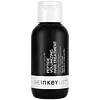What's inside
What's inside
 Key Ingredients
Key Ingredients

 Benefits
Benefits

 Concerns
Concerns

No concerns
 Ingredients Side-by-side
Ingredients Side-by-side

Water
Skin ConditioningPisum Sativum Peptide
Skin ConditioningBetaine
HumectantGlycerin
HumectantPanthenol
Skin ConditioningPEG-40 Hydrogenated Castor Oil
EmulsifyingPhenoxyethanol
PreservativePolyquaternium-37
Citronellyl Methylcrotonate
MaskingEthylhexylglycerin
Skin ConditioningCeratonia Siliqua Seed Extract
Skin ConditioningHydrolyzed Soy Protein
HumectantZea Mays Starch
AbsorbentLeuconostoc/Radish Root Ferment Filtrate
AntimicrobialTrisodium Ethylenediamine Disuccinate
Polyquaternium-16
Potassium Sorbate
PreservativeSodium Benzoate
MaskingGuar Hydroxypropyltrimonium Chloride
Skin ConditioningPolyquaternium-7
Water, Pisum Sativum Peptide, Betaine, Glycerin, Panthenol, PEG-40 Hydrogenated Castor Oil, Phenoxyethanol, Polyquaternium-37, Citronellyl Methylcrotonate, Ethylhexylglycerin, Ceratonia Siliqua Seed Extract, Hydrolyzed Soy Protein, Zea Mays Starch, Leuconostoc/Radish Root Ferment Filtrate, Trisodium Ethylenediamine Disuccinate, Polyquaternium-16, Potassium Sorbate, Sodium Benzoate, Guar Hydroxypropyltrimonium Chloride, Polyquaternium-7
Water
Skin ConditioningPropanediol
SolventCetearyl Alcohol
EmollientHydrolyzed Adansonia Digitata Extract
EmollientKaempferia Galanga Root Extract
Skin ConditioningPunica Granatum Seed Oil
EmollientChondrus Crispus Extract
Skin ConditioningHydrolyzed Jojoba Esters
Skin ConditioningHelianthus Annuus Seed Oil
EmollientTocopherol
AntioxidantSclerotium Gum
Emulsion StabilisingGlycerin
HumectantBehentrimonium Methosulfate
Lactic Acid
BufferingPolyglyceryl-10 Laurate
Skin ConditioningHydroxypropyl Starch Phosphate
PEG-40 Hydrogenated Castor Oil
EmulsifyingParfum
MaskingCinnamal
PerfumingFarnesol
PerfumingBenzyl Benzoate
AntimicrobialAmyl Cinnamal
PerfumingCitronellol
PerfumingCitral
PerfumingHydroxycitronellal
PerfumingGeraniol
PerfumingLimonene
PerfumingLinalool
PerfumingPotassium Sorbate
PreservativeCaprylyl Glycol
EmollientCetrimonium Chloride
AntimicrobialPhenoxyethanol
PreservativeWater, Propanediol, Cetearyl Alcohol, Hydrolyzed Adansonia Digitata Extract, Kaempferia Galanga Root Extract, Punica Granatum Seed Oil, Chondrus Crispus Extract, Hydrolyzed Jojoba Esters, Helianthus Annuus Seed Oil, Tocopherol, Sclerotium Gum, Glycerin, Behentrimonium Methosulfate, Lactic Acid, Polyglyceryl-10 Laurate, Hydroxypropyl Starch Phosphate, PEG-40 Hydrogenated Castor Oil, Parfum, Cinnamal, Farnesol, Benzyl Benzoate, Amyl Cinnamal, Citronellol, Citral, Hydroxycitronellal, Geraniol, Limonene, Linalool, Potassium Sorbate, Caprylyl Glycol, Cetrimonium Chloride, Phenoxyethanol
Ingredients Explained
These ingredients are found in both products.
Ingredients higher up in an ingredient list are typically present in a larger amount.
Glycerin is already naturally found in your skin. It helps moisturize and protect your skin.
A study from 2016 found glycerin to be more effective as a humectant than AHAs and hyaluronic acid.
As a humectant, it helps the skin stay hydrated by pulling moisture to your skin. The low molecular weight of glycerin allows it to pull moisture into the deeper layers of your skin.
Hydrated skin improves your skin barrier; Your skin barrier helps protect against irritants and bacteria.
Glycerin has also been found to have antimicrobial and antiviral properties. Due to these properties, glycerin is often used in wound and burn treatments.
In cosmetics, glycerin is usually derived from plants such as soybean or palm. However, it can also be sourced from animals, such as tallow or animal fat.
This ingredient is organic, colorless, odorless, and non-toxic.
Glycerin is the name for this ingredient in American English. British English uses Glycerol/Glycerine.
Learn more about GlycerinPeg-40 Hydrogenated Castor Oil is derived from castor oil and polyethylene glycol (PEG). It is used as a emollient and emulsifier.
As an emulsifier, it helps prevent ingredients from separating. It also helps make the other ingredients more soluble; it is often used to solubilize fragrances. This increases spreadability and elongates shelf life in a product.
Emollients help soothe and soften the skin. They do this by creating a protective film on your skin. This barrier helps trap moisture and keeps your skin hydrated. Emollients may be effective at treating dry or itchy skin.
This ingredient may or may not be vegan, depending on the source.
Peg-40 Hydrogenated Castor Oil may not be fungal-acne safe. We recommend speaking with a professional if you have any questions or concerns.
Learn more about PEG-40 Hydrogenated Castor OilPhenoxyethanol is a preservative that has germicide, antimicrobial, and aromatic properties. Studies show that phenoxyethanol can prevent microbial growth. By itself, it has a scent that is similar to that of a rose.
It's often used in formulations along with Caprylyl Glycol to preserve the shelf life of products.
Potassium Sorbate is a preservative used to prevent yeast and mold in products. It is commonly found in both cosmetic and food products.
This ingredient comes from potassium salt derived from sorbic acid. Sorbic acid is a natural antibiotic and effective against fungus.
Both potassium sorbate and sorbic acid can be found in baked goods, cheeses, dried meats, dried fruit, ice cream, pickles, wine, yogurt, and more.
You'll often find this ingredient used with other preservatives.
Learn more about Potassium SorbateWater. It's the most common cosmetic ingredient of all. You'll usually see it at the top of ingredient lists, meaning that it makes up the largest part of the product.
So why is it so popular? Water most often acts as a solvent - this means that it helps dissolve other ingredients into the formulation.
You'll also recognize water as that liquid we all need to stay alive. If you see this, drink a glass of water. Stay hydrated!
Learn more about Water